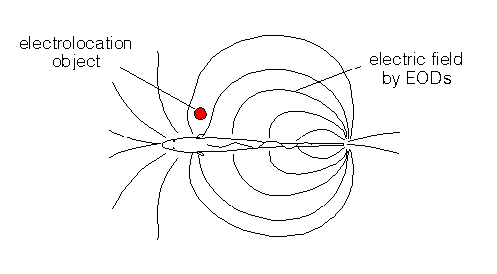Behavioral Neuroscience, Integrative lecture on Jamming Avoidance Response
Jamming
VII. Jamming Avoidance Response
A. Two weakly electric fish meet at night in a dimly lit, murky stream
1. each Eigenmannia virescens has a fixed EOD frequency
a. e.g. Ev1 frequency = first fish Glass Knifefish
i. Ev2 frequency = 2nd fish
2. the frequencies are similar
a. but slightly different
b. higher amplitude and frequency at night
B. The combined signal from the 2 Knifefish are additive
1. constructively
a. where the EOD phase is reinforced
b. i.e. Ev1 acrophase overlaps with Ev2 acrophase
i. nadir with nadir
2. destructively
a. where EOD is out of phase
i. Ev1 acrophase matches Ev2 nadir
(1) antiphase interference
ii. beat minimum
3. Two signals summate - producing a beating waveform
a. peak-to-trough amplitude fluctuates over time
i. rate = frequency difference Ev1:Ev2 EODs
b. slow Ds from beat frequency
i. 'mask' minor frequency Ds
(1) relative motion between Ev1 and enviroment
(2) impair electrolocation
C. Ev1 Tuberous (T) receptors à dELL à dTS à nEb
Ev1 Ampullary (P) receptors à vELL ä
1. detect the concurrent modulations of signal amplitude and timing
a. Electroreceptor array is spread across the body
i. skin has a low electrical resistance
b. in body surface regions that detect foreign EODs
i. compare to signals sensed by a ‘reference’ area
(1) part of the body surface minimally affected
by the foreign signal
2. Ev1 tuberous-R à ELL à dTS
a. comparison of ‘reference’ areas possible due to somatotopic TS
i. feedback from TS à NP à EGp à ELL à TS
b. convergence of Ded frequency signal with ò
3. Ev1 ampullary-R à ELL à dTS
a. Ded amplitude signals
4. weakly electric fish can detect a 100 ns time difference
a. 100 billionths of a second (nanoseconds)
b. example: Ev1 is a bigger fish
i. Ev1 > Ev2 amplitude
ii. Ev1 < Ev2 frequency
(1) Ev1 has longer duration EOD signal
c. Ev1+Ev2 combined signal delayed as amplitude ñ
i. compared to Ev1 EOD
ii. advanced as amplitude ò
D. Ev1 Tuberous-R Glu à AMPA/NMDA:ELL à Glu à AMPA/NMDA:vTS à Glu
Ampullary-R Glu à AMPA/NMDA:ELL à Glu ä
Mechanosensory-R Glu à AMPA/NMDA:ELL à Glu ä
1. à AMPA/NMDA:nEò à GABA
2. GABAA:SPPn àâ Glu à X NMDA àâ relay cell firing rate
a. àâ EMN firing àâ EO discharge àâ frequency EOD
3. Ev1 P + T à ELL à dTS à Glu à AMPA/NMDA:nEb àñbeat frequency
E. Ev2 P + T receptors à ELL à dTS à nEñ à Glu à
1. à AMPA/NMDA:PPnG à Glu à AMPA:Pn pacemaker cells:relay cells
2. relay Gluà ñ AMPA/NMDA:EMN à ACh à Nicotinic-R:electrocyte stack
3. à ñdischarge frequency à ñ EOD frequency
F. Ev1 is a bigger male
1. must establish dominance hierarchy
a. based on the EOD frequencies of conspecifics
i. extrapolating from work on Brachyhypopomus pinnicaudatus
(1) weakly electric fish with biphasic EOD
(2) electrocytes have 2 active membranes
2. Amplitude and duration of EOD waveform ñ at night
a. circadian rhythm
i. enhanced by 5-HT à5-HT1A
(1) inhibited by 5-HT2A/C
b. via the Stress system (HPI axis)
3. Stress: mRaphé à 5-HT àñ 5-HT1A:Hypothalamus àñCRF à Pituitary à
àñ ACTH (+ aMSH)
a. ACTH binds MC2-R àñ Interrenal gland àñ F (cortisol)
b. 5-HT + CRF à ñ EOD via the HPI
c. ACTH + aMSH directly stimulate electrocytes
i. altering membrane biophysics
ii. altering discharge waveforms of electrocytes
4. Breeding season
a. Evf1 EOD > 2X Ev1 EOD frequency
b. HPG àT à ñlong duration masculine EODs
i. shorter duration feminine EODs
ii. Ding kinetics of constituent ionic currents of EOD over days
c. Ev1 à ñEOD frequency
to non-breeding Evf2
d. Ev1 à ñññEOD frequency
to breeding Evf1
5. Social encounters between Ev1 and Ev2 or Ev1 and Evf1 are stressful
a. social encounters: aggression and courtship
i. any stimulus àâ or ñ EOD involves HPI
(1) regulate shape of the electric waveform
(2) and energy available for adaptive social response
b. ACTH + aMSH bind MC5-R on electrocytes àñ cAMP/ PKA
i.
(1) ñ Na+ current
(a) ñ K+ current: inexcitable membrane
(2) in circadian or social Ds
ii. MC5-R also found in striatal muscle
(1) upregulates fatty acid oxidation
(2) neurotrophic at neuromuscular junction
(3) ñACh release à
(4) ñ motor endplate excitability
(5) à ñ muscular AP
c. dominant males ñ amplitude + duration EOD
have â object detection and electrolocation
i. also higher energetics
(1) ñ chance of predation
ii. \ return to fixed normal frequency post-interactions
G. Dominant Ev1 Tuberous-R à ELL à vTS
Ampullary-R à ELL ä
Mechanosensory-R à ELL ä
1. àá nEò à GABA
2. GABAA:SPPn àâ Glu à X NMDA àâ relay cell firing rate
a. àâ EMN firing àâ EO discharge àâ frequency EOD
b. àá recruitment of EMN to be fired àá EOD amplitude
c. short-termñ ACTH ± aMSH à MC5ä
i. mid-termñ testosterone/11KT à ARä
